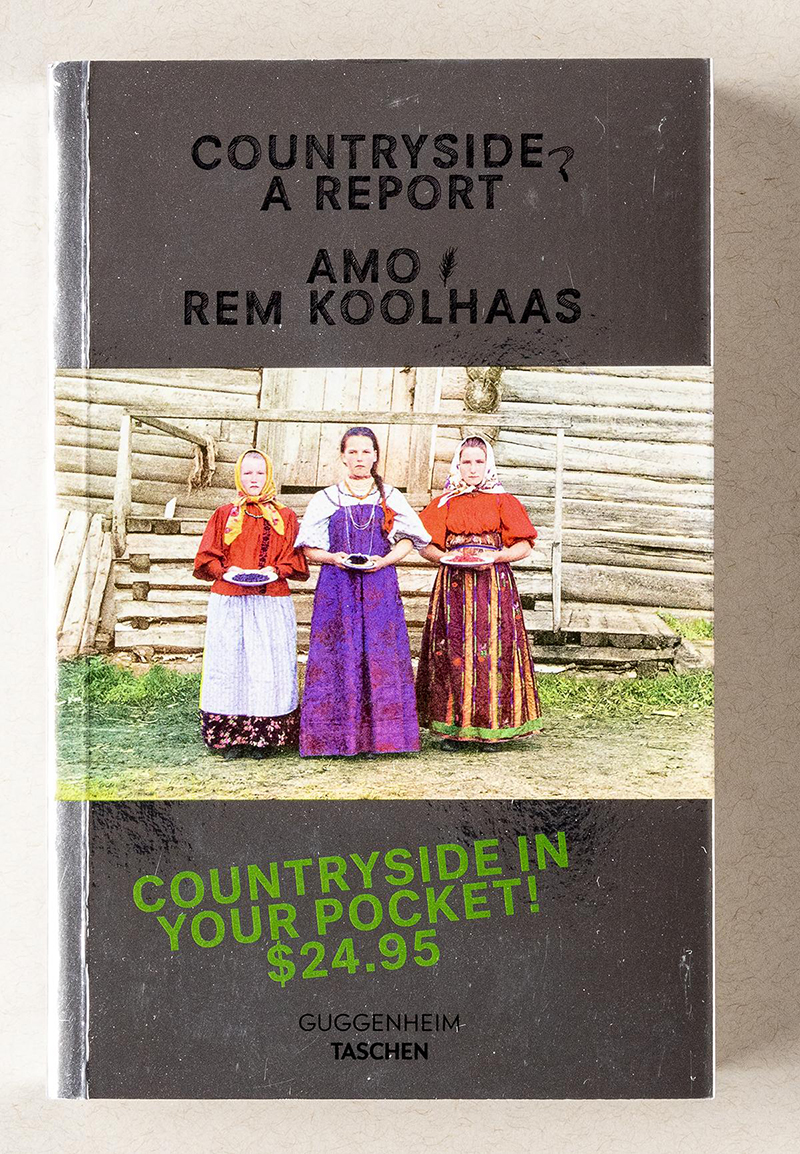Countryside, A Report
Countryside, A Report
AMO, Rem Koolhaas
Taschen, March 2020

Paperback | 4 x 6-1/4 inches | 352 pages | English | ISBN: 978-3836583312 | $25.00
Publisher's Description:




Author Bio:
(Note: Books bought via these links send a few cents to this blog, keeping it afloat.)




Email Subscriptions:
Read The Rest at Archidose
AMO, Rem Koolhaas
Taschen, March 2020

Paperback | 4 x 6-1/4 inches | 352 pages | English | ISBN: 978-3836583312 | $25.00
Publisher's Description:
The rural, remote, and wild territories we call “countryside”, or the 98% of the earth’s surface not occupied by cities, make up the front line where today’s most powerful forces—climate and ecological devastation, migration, tech, demographic lurches—are playing out. Increasingly under a ‘Cartesian’ regime—gridded, mechanized, and optimized for maximal production—these sites are changing beyond recognition. In his latest publication, Rem Koolhaas explores the rapid and often hidden transformations underway across the Earth’s vast non-urban areas.dDAB Commentary:
Countryside, A Report gathers travelogue essays exploring territories marked by global forces and experimentation at the edge of our consciousness: a test site near Fukushima, where the robots that will maintain Japan’s infrastructure and agriculture are tested; a greenhouse city in the Netherlands that may be the origin for the cosmology of today’s countryside; the rapidly thawing permafrost of Central Siberia, a region wrestling with the possibility of relocation; refugees populating dying villages in the German countryside and intersecting with climate change activists; habituated mountain gorillas confronting humans on ‘their’ territory in Uganda; the American Midwest, where industrial-scale farming operations are coming to grips with regenerative agriculture; and Chinese villages transformed into all-in-one factory, e-commerce stores, and fulfillment centers.
This book is the official companion to the Guggenheim Museum exhibition Countryside, The Future. The exhibition and book mark a new area of investigation for architect and urbanist Rem Koolhaas, who launched his career with two city-centric entities: The Office for Metropolitan Architecture (1975) and Delirious New York (1978). It’s designed by Irma Boom, who drew inspiration for the book’s pocket-sized concept, as well as its innovative typography and layout, from her research in the Vatican library.
It's hard not to be cynical in the era of Trump, a liar who uses — flaunting at times — the presidency for personal gain. When it was announced what seems like ages ago that Rem Koolhaas would be taking over the rotunda of the Guggenheim Museum for an exhibition about the countryside, I couldn't help wonder if OMA projects outside of the studio's usual bastion of cities would soon follow. Koolhaas is nothing like Trump, mind you, but I was disappointed to see press releases from AMO/OMA following so closely on the heels of the opening of Countryside, The Future last month: AMO partnering with Volkswagen to "research the future of rural mobility" and OMA being commissioned to design "a shopping center with integrated community spaces in Melbourne's countryside." Perhaps I'm just naive, and it should be expected that the efforts of an architect in one realm (cultural production) should and will lead to work in their practice, but I like the idea of the former standing on its own — or at least not displaying its reciprocity with business as soon as the VW partnership did, which waited all of two weeks.Spreads:
I didn't know of any AMO/OMA commissions extending from Countryside when I visited the Guggenheim one week after it opened (I've yet to write a review of it, mainly because museums are closed these days in response to COVID-19, but also because it's hard to say more about Countryside than what's already been said), but I was aware of them as I read through some of the essays in the pocket-size companion book. Even so, that cynicism didn't really tinge my reading, since the book is comprised mainly of "travelogue essays": Koolhaas, AMO director and Countryside co-curator Samir Bantal, and their collaborators traveling all over the world to learn about "the other 98% of the earth's surface not occupied by cities." There is sincerity in these pieces, which range from industrial farming in the American Midwest to the depleting permafrost in Russia's Yakutia region. The best essays involve experts and therefore exhibit a desire to learn how things actually work in the countryside, as opposed to just observing things from a distance and then fitting those views into intuitive theories, as Koolhaas is wont to do. Compared to the exhibition, I find the book much more rewarding, since it delves (a little bit) deeper into the subjects that are presented on the ramps of the Guggenheim in bite-size illustrations, collaged together in a manner that is confusing at times. The book, designed by Irma Boom, has a welcome clarity, while its small size belies Countryside's pretensions.




Author Bio:
AMO is the think tank of the Office for Metropolitan Architecture (OMA), co-founded by Rem Koolhaas in 1999. Rem Koolhaas is a co-founder of the Office for Metropolitan Architecture. ... Among many international awards, he has received the Pritzker Prize (2000) and the Praemium Imperiale (2003).Purchase Links:
(Note: Books bought via these links send a few cents to this blog, keeping it afloat.)




Email Subscriptions:
Subscribe to A Daily Dose of Architecture Books by Email













